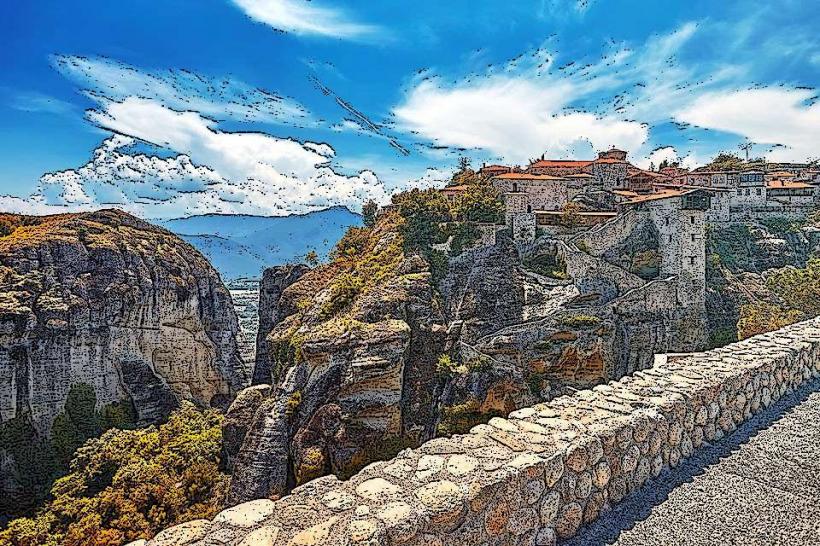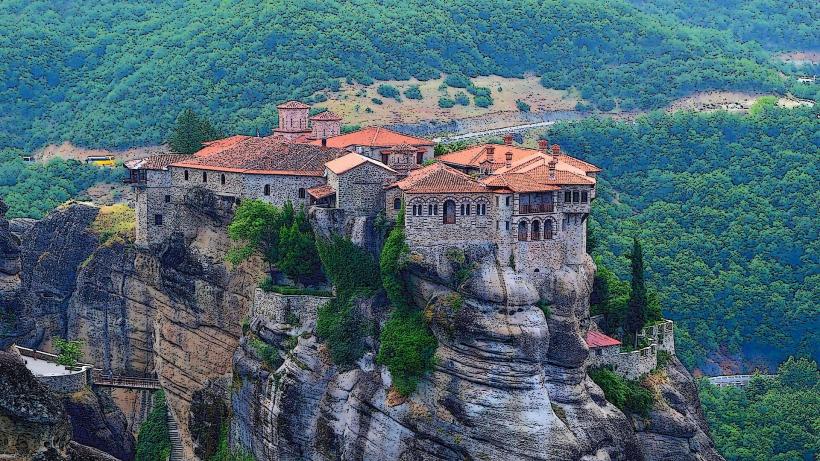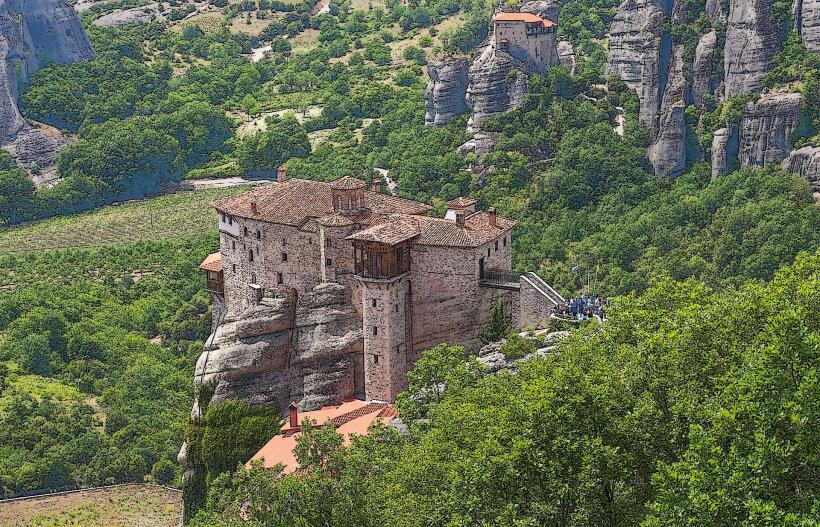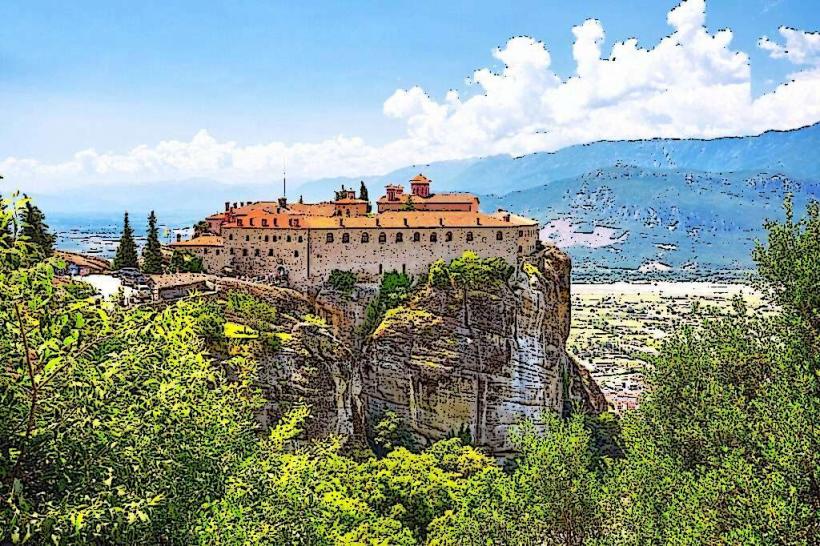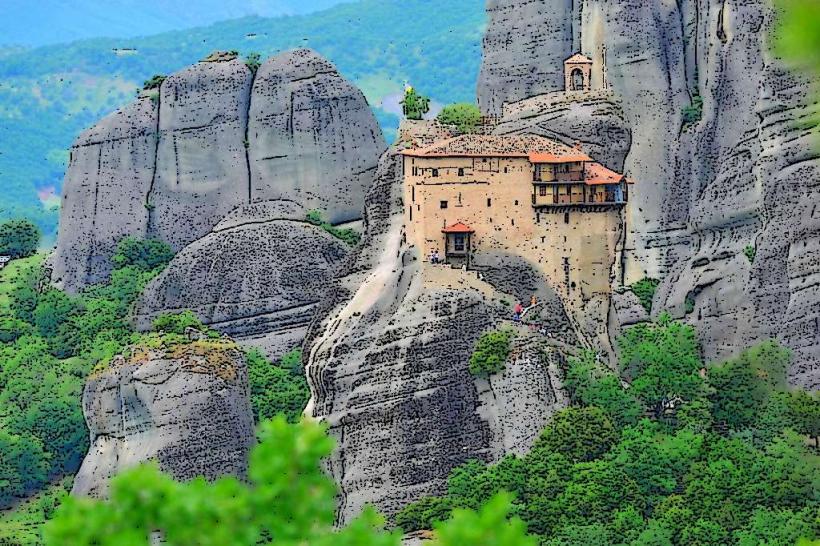Information
Landmark: Holy Trinity MonasteryCity: Meteora
Country: Greece
Continent: Europe
Holy Trinity Monastery (also known as Agia Triada Monastery) is one of the most famous and visually striking monasteries in the Meteora region of central Greece. It is perched atop one of the towering rock formations in Meteora and is renowned for its stunning views, historical significance, and religious importance. The monastery's unique location and its beautiful architectural design make it a popular destination for visitors to the Meteora complex.
1. Historical Background
Foundation and Early History: The Holy Trinity Monastery is believed to have been founded in the 14th century by monks seeking to live a life of solitude and prayer in the remote and inhospitable rock formations of Meteora. Some sources suggest that the monastery was established around 1372. Initially, it was a small hermitage for monks who lived a secluded, ascetic lifestyle.
Development: The monastery gradually grew in size and importance during the 16th century. Like many other Meteora monasteries, it flourished during this time, attracting monks and pilgrims alike. The monastery was constructed in a typical Byzantine style, with a main church (katholikon) at the heart of the complex. Over time, the Holy Trinity Monastery became a significant center for religious life and learning.
Decline: As with many of the Meteora monasteries, the Ottoman period in Greece, especially during the 18th century, led to a decline in the monastic population. Despite this, the monastery remained an active place of worship, though it lost much of its earlier influence compared to larger monasteries such as Great Meteoron and Varlaam.
Restoration: In the 20th century, efforts were made to restore and preserve the monastery. Its buildings, frescoes, and other religious artifacts were carefully conserved. Today, the Holy Trinity Monastery is one of the best-preserved and most visited monasteries in Meteora, attracting both pilgrims and tourists from around the world.
2. Architecture and Layout
Holy Trinity Monastery is located at a remarkable height of approximately 400 meters (1,312 feet) above sea level. Like other Meteora monasteries, the complex is built into the natural rock formations, which provide both stunning views and protection. The monastery is known for its simple yet elegant architecture, as well as its impressive location on a rock that is difficult to access.
Location and Accessibility: The monastery is perched atop a steep rock and was originally only accessible by ropes and ladders. Today, however, visitors can reach the monastery via a set of stairs that lead up the rock formation. The view from the monastery is breathtaking, offering a panoramic view of the surrounding Meteora rock pillars and the Thessalian Plain below.
Monastery Complex: The buildings of the monastery are clustered around a central courtyard. Key features of the complex include:
- Katholikon (Main Church): The main church of the monastery is dedicated to the Holy Trinity. The katholikon is an important example of Byzantine ecclesiastical architecture, with its central dome, nave, and altar. The church is adorned with beautiful frescoes depicting scenes from the life of Christ, the Virgin Mary, and various saints.
- Cells and Rooms: The monastery includes several monks' cells and other rooms such as a refectory (dining hall), rooms for prayer and study, and a library containing religious texts. These rooms are simple but functional, in keeping with the monastic life of asceticism and devotion.
- Defensive Features: Like other monasteries in Meteora, the Holy Trinity Monastery was built with defensive considerations in mind. The rocky terrain and strategic location provided natural protection, while the stone walls and watchtowers added additional security. The monastery was isolated from the outside world, making it a safe refuge for monks and religious pilgrims.
3. Frescoes and Art
The frescoes inside Holy Trinity Monastery are one of its most impressive artistic features. They are typical of the Byzantine and post-Byzantine periods, rich in religious symbolism and vibrant colors.
Frescoes in the Katholikon: The walls of the main church are covered in beautiful frescoes that depict biblical scenes and the lives of saints. The frescoes are the work of several famous iconographers, particularly from the 16th century. Some of the scenes depicted include the Life of Christ, the Last Judgment, and images of various saints and biblical figures.
Iconostasis: The iconostasis, or screen separating the altar from the rest of the church, is a stunning feature in itself. It is adorned with a series of icons depicting important Christian figures, including Christ, the Virgin Mary, and various saints. The icons are painted in vivid colors and showcase the artistic mastery of the iconographers who created them.
Other Sacred Artifacts: The monastery also houses a collection of liturgical vessels, manuscripts, and other religious artifacts that highlight the spiritual life of the community.
4. Religious and Cultural Significance
Monastic Life: Holy Trinity Monastery was established as a place of deep spiritual reflection, prayer, and ascetic living. Like other Meteora monasteries, it was a center for monastic life, where monks dedicated themselves to the practice of Orthodox Christianity. The monks lived in isolation, following strict religious rituals and devoting their lives to the service of God.
Pilgrimage Site: Over the centuries, the monastery became a significant pilgrimage site for Orthodox Christians. Pilgrims would travel to the monastery to seek spiritual guidance, participate in religious services, and enjoy the peaceful and tranquil environment.
Cultural Legacy: The monasteries of Meteora, including Holy Trinity, played an essential role in preserving Greek culture, art, and religious practices during the Ottoman occupation. The monasteries were often centers of resistance and intellectual life, keeping the traditions of the Greek Orthodox Church alive through centuries of foreign domination.
5. Visitor Experience
Accessibility: Visitors to the Holy Trinity Monastery can access the site by a series of steps that climb the rock pillar where the monastery is located. Although the climb is somewhat steep, it is relatively easy to navigate, and the effort is rewarded with one of the most impressive views in Meteora. The monastery is relatively small, making it more intimate and manageable compared to some of the larger monasteries.
Monastery Grounds: Once inside the monastery, visitors can explore the church with its stunning frescoes, the iconostasis, and the cells where the monks lived. The views from the monastery’s terraces are some of the most breathtaking in Meteora, offering a panoramic vista of the surrounding rock formations and the fertile Thessalian Plain below.
Museum and Artifacts: The monastery has a small museum where visitors can view religious artifacts, liturgical objects, and ancient manuscripts. These items offer a glimpse into the monastic lifestyle and the spiritual history of the monastery.
6. UNESCO World Heritage Site
Holy Trinity Monastery is part of the Meteora UNESCO World Heritage Site, which recognizes the natural and cultural significance of the area. Meteora’s unique rock formations and its monasteries have been designated as a World Heritage site due to their exceptional beauty and importance as a center of religious life.
7. Today
Active Monastery: Today, Holy Trinity Monastery remains an active center of worship and spiritual life. Although the number of monks is small, the monastery continues to function as a place of prayer and pilgrimage. Visitors are welcome to attend services and experience the tranquility and beauty of the monastery.
Tourism: Holy Trinity Monastery is one of the most visited monasteries in Meteora. Its location and the artistic treasures within make it a popular stop for tourists exploring the Meteora region. The monastery's peaceful atmosphere and spectacular views also make it a great place for visitors to relax and take in the beauty of the surrounding landscape.
Conclusion
Holy Trinity Monastery is a remarkable and picturesque part of the Meteora complex, known for its stunning architecture, beautiful frescoes, and breathtaking location. Its historical significance, coupled with its spiritual importance, makes it a must-visit destination for anyone exploring Meteora. Whether for its religious history, artistic treasures, or simply the awe-inspiring views, Holy Trinity Monastery stands as a testament to the enduring legacy of Orthodox monasticism in Greece.

